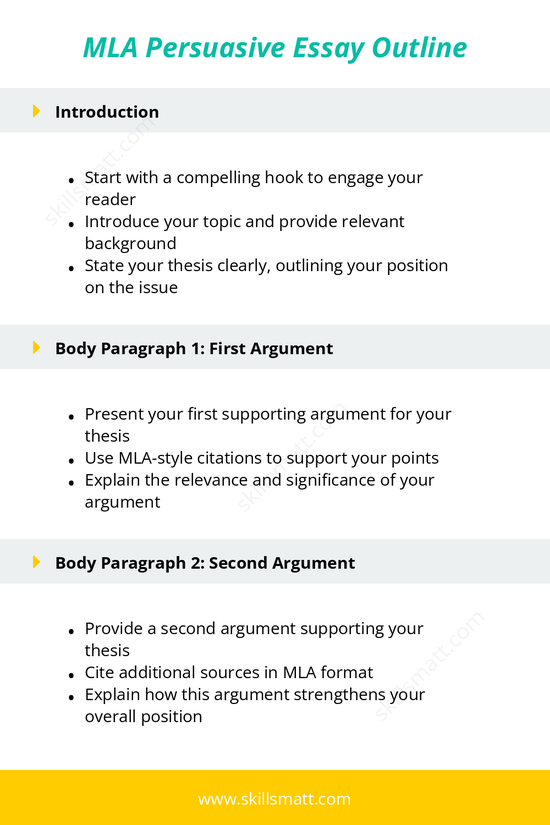MLA Persuasive Essay Outline
When writing a persuasive essay using MLA format, it’s important to follow a clear structure while adhering to MLA’s guidelines for citations and formatting. The outline below offers a comprehensive guide for structuring your persuasive essay, from the introduction to the conclusion, with a focus on presenting well-supported arguments and citing credible sources.
Introduction
The introduction of a persuasive essay is key to capturing the reader’s attention and establishing the context for your argument. In this section, you’ll introduce the topic, provide relevant background information, and present your thesis statement clearly.
- Start with a compelling hook to engage your reader: Begin your essay with an attention-grabbing sentence that will draw your reader in. This could be a provocative question, an interesting statistic, or an impactful quote related to the topic.
- Introduce your topic and provide relevant background: After the hook, give your reader some context about the issue at hand. Explain why the topic is important and provide any necessary background information for understanding the issue.
- State your thesis clearly, outlining your position on the issue: Your thesis should clearly express your stance on the topic and summarize the main argument you will be making in your essay. It should be concise but direct.
Body Paragraph 1: First Argument
The first body paragraph is where you’ll present your first supporting argument. This should be your strongest argument, well-supported by evidence from credible sources.
- Present your first supporting argument for your thesis: Introduce your first key point and explain how it supports your thesis. This argument should be clear and relevant to your overall position.
- Use MLA-style citations to support your points: MLA format requires you to cite your sources properly within the text. For this paragraph, include MLA in-text citations to provide evidence for your argument. For example, you can cite a quote or paraphrase from a book or article by including the author’s last name and page number (e.g., Smith 123).
- Explain the relevance and significance of your argument: After presenting evidence, explain how it supports your thesis and why it matters in the context of your overall argument. Make sure your reader understands the significance of this evidence in strengthening your position.
Body Paragraph 2: Second Argument
The second body paragraph will present another supporting argument, further strengthening your thesis. This argument should be another well-researched point that complements your first argument.
- Provide a second argument supporting your thesis: Present your second key argument, which should add more weight to your overall position. This argument should be distinct from the first but still related to the main thesis.
- Cite additional sources in MLA format: As with the first argument, make sure to cite all sources properly in MLA format. You can introduce another scholarly article or data point to support this argument, ensuring all references are cited in-text correctly (e.g., Johnson 45).
- Explain how this argument strengthens your overall position: Link this argument back to your thesis, explaining how it further supports your position. Show the reader how this new evidence builds on the first argument and provides additional proof for your viewpoint.
Conclusion
Although not included in this outline, remember that the conclusion should restate your thesis in a new way, summarize your main arguments, and end with a final thought that emphasizes the importance of your position. In MLA format, remember to cite any sources used throughout the essay, both in-text and on the Works Cited page at the end.
By following this MLA persuasive essay outline, you will ensure that your essay is both well-organized and properly formatted according to MLA guidelines. The clear structure and accurate citations will make your essay compelling, credible, and persuasive.

